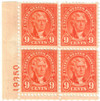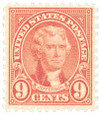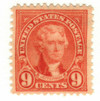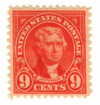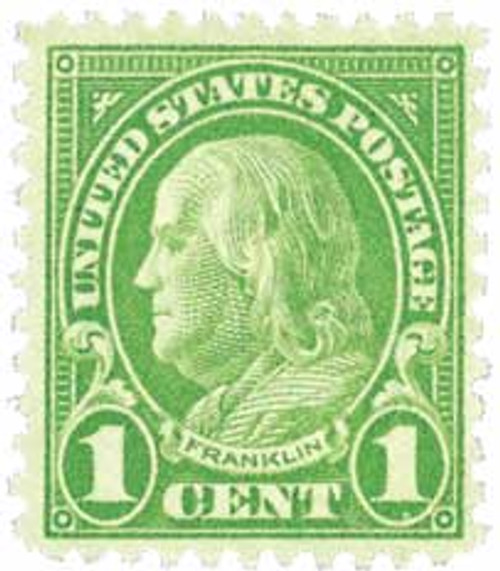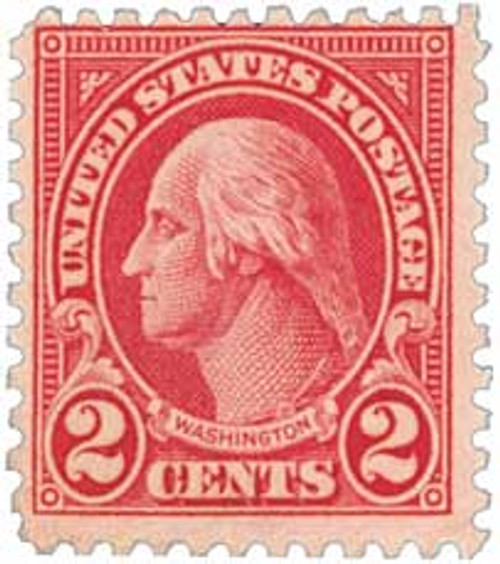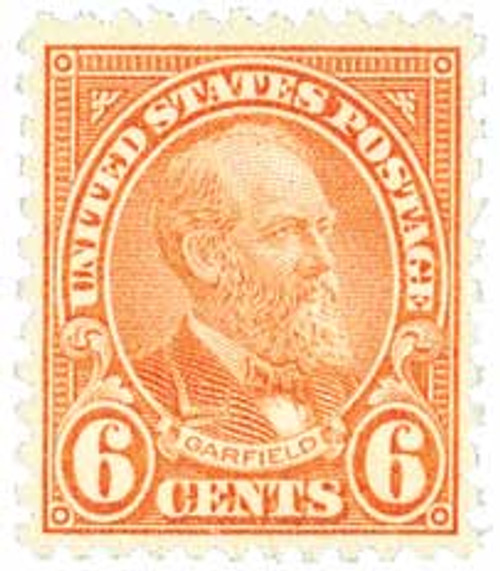
1927 9c Jefferson, orange red
# 641 - 1927 9c Jefferson, orange red
$0.35 - $450.00
U.S. #641
1926-28 Rotary Stamp
9¢ Jefferson
Perforated 11 x 10.5
1926-28 Rotary Stamp
9¢ Jefferson
Perforated 11 x 10.5
Issue Date: May 17, 1927
First City: Washington, DC
The 1926-28 rotary stamps used the designs of the flat plate Series of 1922-25. The 9¢ denomination pictures Thomas Jefferson, one of the most brilliant men in our nation’s history. Describing a dinner hosted for Nobel Prize winners, President John F. Kennedy once said, “I think this is the most extraordinary collection of talent, of human knowledge, that has ever been gathered at the White House - with the possible exception of when Thomas Jefferson dined alone.”
In 1775, Jefferson was selected to serve as a member of the Continental Congress. He quickly became a leader of that congress, and was asked to draft a “Declaration of the Causes and Necessity of Taking up Arms,” after the American Revolution began. Jefferson was a member of the committee appointed to draft a declaration of independence. The other members, which included John Adams, Benjamin Franklin, Roger Sherman, and Robert Livingston, unanimously selected Jefferson to prepare the first draft – and they approved it with very few changes.
The Declaration of Independence is Jefferson’s masterpiece, as well as his best-known work. Jefferson said his goal was to “place before mankind the common sense of the subject, in terms so plain and firm as to command their assent....” The Declaration of Independence stated, with moving eloquence, the position of the American patriots, and backed it up with strong legal argument. Although few of the ideas contained within the Declaration were new, it summarized and stated the American cause so well, many historians agree that it ranks among the greatest documents in human history. Its statement that all people have certain rights has inspired freedom-loving people all over the world.
Jefferson resigned from the Continental Congress in September 1776, and rejoined the Virginia House of Delegates. He had no interest in military affairs and felt he would best serve as a lawmaker in Virginia. Jefferson dedicated himself to creating laws reforming land ownership and protecting religious freedom, as well as other improvements. The Virginia Assembly elected Jefferson governor to one-year terms in 1779 and 1780. During that time, Virginia sent most of its armed forces to fight elsewhere, as ordered by General Washington. When British forces invaded, Jefferson himself was nearly captured. The people of Virginia criticized Jefferson for leaving the state defenseless. Although an investigation cleared his name, it was years before Jefferson’s reputation was fully restored in Virginia.
In 1783, Jefferson was elected to Congress. He was key in shaping the Treaty of Paris, which ended the Revolutionary War. In May 1784, Congress sent Jefferson to France to aid in negotiating commerce treaties. The next year, Franklin resigned as Minister to France, and Jefferson replaced him. He returned to the U.S. in 1789, and President Washington immediately requested that he serve as the Secretary of State. During this period, Jefferson and Alexander Hamilton grew to become fierce political rivals. However, President Washington supported most of Jefferson’s foreign policies.
Jefferson was nominated by the Democratic-Republican Party as a candidate for President in the 1796 election. Jefferson finished second after John Adams, and according to the law of the day, became the vice-president. However, as the government was dominated by the Federalist Party, Jefferson had little to do with the administration.
U.S. #641
1926-28 Rotary Stamp
9¢ Jefferson
Perforated 11 x 10.5
1926-28 Rotary Stamp
9¢ Jefferson
Perforated 11 x 10.5
Issue Date: May 17, 1927
First City: Washington, DC
The 1926-28 rotary stamps used the designs of the flat plate Series of 1922-25. The 9¢ denomination pictures Thomas Jefferson, one of the most brilliant men in our nation’s history. Describing a dinner hosted for Nobel Prize winners, President John F. Kennedy once said, “I think this is the most extraordinary collection of talent, of human knowledge, that has ever been gathered at the White House - with the possible exception of when Thomas Jefferson dined alone.”
In 1775, Jefferson was selected to serve as a member of the Continental Congress. He quickly became a leader of that congress, and was asked to draft a “Declaration of the Causes and Necessity of Taking up Arms,” after the American Revolution began. Jefferson was a member of the committee appointed to draft a declaration of independence. The other members, which included John Adams, Benjamin Franklin, Roger Sherman, and Robert Livingston, unanimously selected Jefferson to prepare the first draft – and they approved it with very few changes.
The Declaration of Independence is Jefferson’s masterpiece, as well as his best-known work. Jefferson said his goal was to “place before mankind the common sense of the subject, in terms so plain and firm as to command their assent....” The Declaration of Independence stated, with moving eloquence, the position of the American patriots, and backed it up with strong legal argument. Although few of the ideas contained within the Declaration were new, it summarized and stated the American cause so well, many historians agree that it ranks among the greatest documents in human history. Its statement that all people have certain rights has inspired freedom-loving people all over the world.
Jefferson resigned from the Continental Congress in September 1776, and rejoined the Virginia House of Delegates. He had no interest in military affairs and felt he would best serve as a lawmaker in Virginia. Jefferson dedicated himself to creating laws reforming land ownership and protecting religious freedom, as well as other improvements. The Virginia Assembly elected Jefferson governor to one-year terms in 1779 and 1780. During that time, Virginia sent most of its armed forces to fight elsewhere, as ordered by General Washington. When British forces invaded, Jefferson himself was nearly captured. The people of Virginia criticized Jefferson for leaving the state defenseless. Although an investigation cleared his name, it was years before Jefferson’s reputation was fully restored in Virginia.
In 1783, Jefferson was elected to Congress. He was key in shaping the Treaty of Paris, which ended the Revolutionary War. In May 1784, Congress sent Jefferson to France to aid in negotiating commerce treaties. The next year, Franklin resigned as Minister to France, and Jefferson replaced him. He returned to the U.S. in 1789, and President Washington immediately requested that he serve as the Secretary of State. During this period, Jefferson and Alexander Hamilton grew to become fierce political rivals. However, President Washington supported most of Jefferson’s foreign policies.
Jefferson was nominated by the Democratic-Republican Party as a candidate for President in the 1796 election. Jefferson finished second after John Adams, and according to the law of the day, became the vice-president. However, as the government was dominated by the Federalist Party, Jefferson had little to do with the administration.



